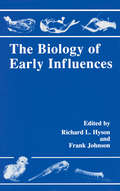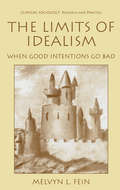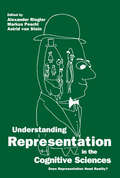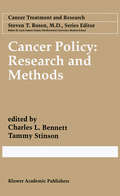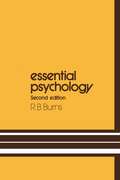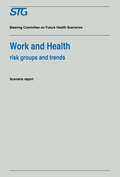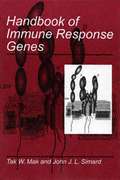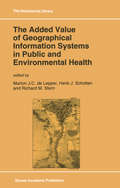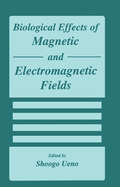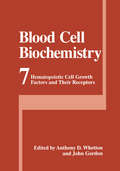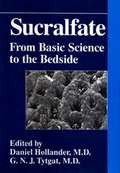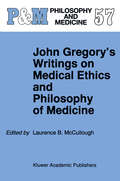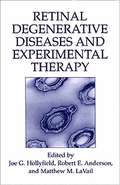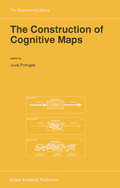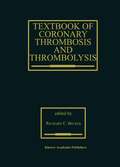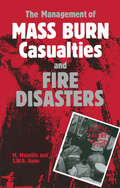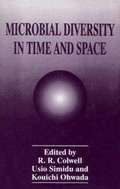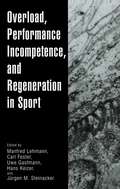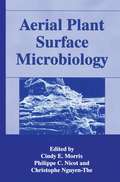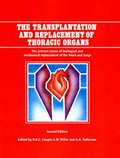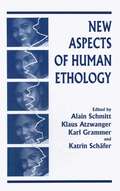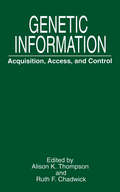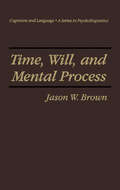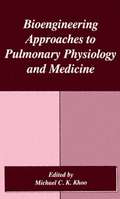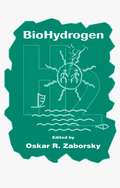- Table View
- List View
The Biology of Early Influences
by Richard L. Hyson Frank JohnsonThe underlying theme of this book the role of experience in the development of the nervous system. It is now widely acknowledged that there are a variety of organi- environment interactions that guide the development of the nervous system. The popular press has also picked up on this theme and parents are being advised to enrich their child's sensory experience as early as possible. The importance of experience in development is so well accepted that it has begun to dictate public policy. In 1997, the President and First Lady hosted "The White House Conference on Early Childhood Development and Learning: What New Research on the Brain Tells Us About Our Youngest Children. " Along with this conference came a reemphasis on programs directed at enriching the en- ronment of America's youth. In some cases laws have been passed to assure enhanced early experience. In Georgia, the former governor proposed sending newborn children home from the hospital with classical music CDs. This received some praise, but was also ridiculed by others who felt the policy was not justified by the available scientific evidence. Here in Florida, enhanced "brain development activities" are mandated for sta- funded child care facilities. Chapter 402. 25 of the 1998 State of Florida Statues reads (emphasis added): Infants and toddlers in state-funded education and care programs; brain development activities.
The Limits of Idealism: When Good Intentions Go Bad (Clinical Sociology: Research and Practice)
by Melvyn L. FeinIf the truth be known, I am only a partially reformed idealist. In the secret depths of my soul, I still wish to make the world a better place and sometimes fantasize about heroically eradicating its faults. When I encounter its limitations, it is consequently with deep regret and continued surprise. How, I ask myself, is it possible that that which seems so fight can be a chimera? And why, I wonder, aren't people as courageous, smart, or nice as I would like? The pain of realizing these things is sometimes so intense that I want to close my eyes and lose myself in the kinds of daydreams that comforted me as a youngster. One thing is clear, my need to come to grips with my idealism had its origin in a lifetime of naivet6. From the beginning, I wanted to be a "good" person. Often when life was most treacherous, I retreated into a comer from whence I escaped into reveries of moral glory. When I was very young, my faith was in religion. In Hebrew school, I took my lessons seriously and tried to apply them at home. By my teen years, this had been replaced by an allegiance to socialism. In the Brooklyn where I grew up, my teachers and relatives made this seem the natural course. When I reached my twenties, however, and was obliged to confront a series of personal deficiencies, psychotherapy shouldered its way to the fore.
Understanding Representation in the Cognitive Sciences: Does Representation Need Reality?
by Alexander Riegler Markus Peschl Astrid Von Steinurrently a paradigm shift is occurring in for the conventional understanding of represen- which the traditional view of the brain as tions. The paper also summarizes the rationale for C representing the "things of the world" is the selection of contributions to this volume, which challenged in several respects. The present volume will roughly proceed from relatively "realist" c- is placed at the edge of this transition. Based on the ceptions of representation to more "constructivist" 1997 conference "New Trends in Cognitive Sci- interpretations. The final chapter of discussions, ence" in Vienna, Austria, it tries to collect and in- taped during and at the end of the conference, p- grate evidence from various disciplines such as p- vides the reader with the possibility to reflect upon losophy of science, neuroscience, computational the different approaches and thus contributes to b- approaches, psychology, semiotics, evolutionary ter and more integrative understanding of their biology, social psychology etc. , to foster a new thoughts and ideas. understanding of representation. The subjective experience of an outside world This book has a truly interdisciplinary character. It seems to suggest a mapping process where environ- is presented in a form that is readily accessible to mental entities are projected into our mind via some professionals and students alike across the cognitive kind of transmission. While a profound critique of sciences such as neuroscience, computer science, this idea is nearly as old as philosophy, it has gained philosophy, psychology, and sociology.
Cancer Policy: Research And Methods (Cancer Treatment and Research #97)
by Charles L. Bennett Tammy StinsonPolicy and outcome studies represent a new area of research in oncology. Understanding the factors that affect quality of life, costs of care, patterns of care, and outcomes in oncology is important to providing comprehensive care. Health services is meant to be both a productive area of research as well as a discipline that improves patient decision making. In sum, Cancer Policy highlights some of the important areas of health services research in oncology.
Essential Psychology: For Students And Professionals In The Health And Social Services
by R.B. BurnsWhile this book is concerned with psychology let no reader believe that after studying it he or she will be a budding psychologist. Only those elements of psychology which are central to the adequate functioning of the professional in the health and allied caring services are covered. Many popular topics, such as intelligence, memory, concept formation, will not be found within the covers of this book. The objective of this book is to enable those professionals who have responsibility for the well-being, health and care of others to develop insight into and to become more empathetic to the needs, motivations, feelings and behaviour of their charges. An ancillary objective is that the readers too might come to understand a little more about their own behaviour, particularly in relation to their work situation. Patients in hospital, children in residential care, the elderly in the old folks' home are all perceiving and thinking organisms, not merely interesting medical cases, a classical set of symptoms, a collection of statistics or a bulging case file. Every person, whether professional or client, is affected by the way others respond to them, by the feelings each has for the other, by the non-verbal signals of eye contact, smile, and voice tone, etc.
Work and Health: Risk Groups and Trends Scenario Report Commissioned by the Steering Committee on Future Health Scenarios (Future Health Scenarios)
by Scenario Committee on Work and HealthHandbook of Immune Response Genes
by Tak W. Mak John J. SimardThe study of immunology encompasses a vast and ever-growing body of information that in some way or other incorporates most areas of medical biological research. As the body of information in the medical sciences continues to increase its rate of expansion, one of the greatest challenges to investigators will be to integrate this information in a manner that is intellectually fruitful and productive. Considering the intended scope of this text, we could not pretend to have gone too far toward achieving such an integration--and considering the pace of change, in its very best form a measured approximation of such lofty goals might be the most we could hope for. Nevertheless, in these pages we have sought to produce a collection of information that is at once concise and up-to-date regarding areas where important developments are impacting on the way we understand the vertebrate immune system. In addition, although the information is geared toward advanced study, we have discussed some basic elements and concepts that we hope make the text a useful resource for both the immunologist and the nonspecialist. The intention is to provide the researcher, clinician, or advanced undergraduate student with a brief ov- view of specific components of the immune system, and to provide a place from which to begin further detailed study if necessary. To this end, we made every effort to supply extensive referencing--although limitations in space prevented exhaustive or complete referencing in some cases.
The Added Value of Geographical Information Systems in Public and Environmental Health (GeoJournal Library #24)
by Marion J. C. De LepperHealth for all by the year 2000 is the blueprint for change agreed to by the Member States of the World Health Organization. In Europe, this blueprint is built on 38 regional targets, many of which have the underlying aim of uncovering new knowledge and of using existing knowledge more effectively. The targets related to a healthy environment have the ultimate goals of safeguarding human health against environmental hazards, and of enhancing the quality of life by providing clean and safe water, air, food, and working and living conditions. Allied to these goals is the need to reduce the sense of jeopardy that many people feel about what they perceive as 'the risks of everyday life'. These goals are an integral part of the European Charter on Environment and Health, adopted by 29 European Member States and the Commission of the European Communities in December 1989. The Charter stresses the shared responsibility of everyone to protect the environment, to be given adequate and accurate information, and to be involved in decision-making. It outUnes the principles for public policy as well as what needs to be done to transform them into action. In this, strong information systems have a vital role to play by helping to monitor the effectiveness of measures taken, of trends analysed, of priorities set and of decisions made.
Biological Effects of Magnetic and Electromagnetic Fields
by Shoogo UenoThe International Symposium on Biological Effects of Magnetic and Electrom- netic Fields was held from September 3-4, 1993 at Kyushu University in Fukuoka . Japan . Originally, it was only intended to be an informal gathering of many scientists who had accepted my invitation to visit Kyushu University after the XXIVth General Assembly of the International Union of Radio Science (URSI), held in Kyoto prior to our symposium . However, since so many distinguished scientists were able to come, it was decided that a more formal symposium would be possible . It was a very productive symposium and, as a result, many of the guests consented that it would be a good idea to gather all the information put forth at the meeting and have it published. In addition, although they were unfortunately unable to attend the symposium . many other distinguished scientists had also expressed their wish to contribute to this effort and, in so doing. help to increase understanding in this, as yet, relatively immature field of science . The question of both positive and negative effects of magnetic and electromagnetic fields on biological systems has become more and more important in our world today as they .
Blood Cell Biochemistry: Hematopoietic Cell Growth Factors and Their Receptors (Blood Cell Biochemistry #7)
by JohnGordon Anthony D. WhettonHistorically, the field of hematopoietic growth factor research began with the work of Carnot and Deflandre-in 1906 they suggested that the rate of erythropoiesis is regulated by a humoral factor found in the blood, namely, erythropoietin. From this comparatively early start, accelerating progress has been made in erythropoietin research, which demon strates the general trends in this field of study. Erythropoietin was purified to homogeneity by 1977 (from enormous quantities of urine from aplastic anemia patients). Subsequently, the gene for erythropoietin has been cloned (1985), and massive quantities of this growth factor have been produced for clinical trials (late 1980s onward). Erythropoietin has become established as a pharmaceutical product of great value in the treatment of a number of diseases, most notably chronic renal failure. Once the ligand had been cloned, interest turned to the erythropoietin receptor, which was cloned in 1989. Since then, structure/ function studies have been performed on receptor mutants, cellular signaling events down stream from the occupied receptor have been identified, and the specific producer cell types and molecular stimuli for erythropoietin production have been thoroughly investigated, as has the regulation of erythropoietin gene transcription. This schedule of events since the 1970s typifies that seen for a number of hematopoietic growth factors. Along the way, the hematopoietic growth factors have been recognized as members of the cytokine family of signaling molecules that are important in a number of different physiological and patholog ical situations (see below).
Sucralfate: From Basic Science to the Bedside
by Guido N. J.Tytgat DanielHollanderInternational researchers summarize the current understanding of peptic disease and trace the development of a novel new drug for peptic disease therapy-sucralfate. Contributors present laboratory research along side data from clinical trials as well as from the practice of medicine. Articles discuss the history of sucralfate's development, mechanisms of action, clinical efficacy, and future directions for research. This volume will be of interest to scientists and clinicians working in gastroenterology and gastrointestinal physiology.
John Gregory's Writings on Medical Ethics and Philosophy of Medicine (Philosophy and Medicine #57)
by John Gregory Laurence B. McCulloughThis volume introduces a new subseries of Philosophy and Medicine, Classics of Medical Ethics. The purpose of this new subseries is to bring out scholars' editions of major works in the history of medical ethics and philosophy of medicine. This new subseries will target for publication texts that are long out of print and difficult to access. Each volume will contain an introduction to the writings on medical ethics and philosophy of medicine produced by the original author. Each volume will also contain a guide to the primary and major secondary Hterature, to facilitate teaching and scholarship in bioethics, philosophy of medicine, and history of medicine. Texts will be presented in their origi nal style and will provide pagination of the original, so that citations can be made either to the original text or to the page numbers in these vol umes. Finally, each volume will be well indexed, again to facilitate teaching and research. Bioethics and philosophy of medicine - the former more so than the latter - have an insufficiently developed understanding of themselves as having a history. As a consequence, these fields lack the maturity that critical dialogue of the past with the present provides for other fields and disciplines of the humanities. To the extent that this problem is due to the fact that major primary historical sources are not readily available, this subseries will contribute to the further development and maturation of bioethics and philosophy of medicine as fields of the humanities.
Retinal Degenerative Diseases and Experimental Therapy: Mechanisms And Experimental Therapy (Advances In Experimental Medicine And Biology Ser. #1185)
by Joe G. HollyfieldTo create a forum for scientists and clinicians interested in degenerative retinal diseases, we began in 1984 to organize a biennial symposium on Retinal Degeneration as a satellite meeting of the International Congress of Eye Research. The timing and varying location of these meetings provides an important assembly for investigators from throughout the world to convene for presentation of their new findings on the causes and potential therapies for degenerative retinal disorders. The VIII International Symposium on Retinal Degeneration was held from July 28-25, 1998, at the Hotel Vier Jahreszeiten in Schluchsee, a small town in the Black Forest of southwestern Germany. Most of the participants in this meeting contributed to this volume, and we are appreciative of the efforts of each author in making this publication possible. The research presented at the meeting, and described in this proceedings volume, reflects a strong emphasis on the molecular genetic approach to understa- ing these disorders. Several of the papers provide important new insights into the mechanism of photoreceptor degeneration and cell death. A number of the studies are targeted at retarding or reversing the degeneration process. Included for the first time are presentations from all the principal laboratories involved in the field of visual prostheses-implant (chip) technology-in which investigations are targeted at restoring vision in eyes that have lost photoreceptor cells. A variety of diagnostic, clinical, histopathological, and physiological assessments of retinal degeneration in patients are also included.
The Construction of Cognitive Maps (GeoJournal Library #32)
by Juval Portugaliand processes which are exclusive to humans in their encoding, storing, decoding and retrieving spatial knowledge for various tasks. The authors present and discuss connectionist models of cognitive maps which are based on local representation, versus models which are based on distributed representation, as well as connectionist models concerning language and spatial relations. As is well known, Gibson's (1979) ecological approach suggests a view on cognition which is diametrically different from the classical main stream view: perception (and thus cognition) is direct, immediate and needs no internal information processing, and is thus essentially an external process of interaction between an organism and its external environment. The chapter by Harry Heft introduces J. J. Gibson's ecological approach and its implication to the construction of cognitive maps in general and to the issue of wayfinding in particular. According to Heft, main stream cognitive sciences are essentially Cartesian in nature and have not as yet internalized the implications of Darwin's theory of evolution. Gibson, in his ecological approach, has tried to do exactly this. The author introduces the basic terminology of the ecological approach and relates its various notions, in particular optic flow, nested hierarchy and affordances, to navigation and the way routes and places in the environment are learned.
Textbook of Coronary Thrombosis and Thrombolysis (Developments in Cardiovascular Medicine #193)
by Richard C. BeckerTeleologically, the hemostatic mechanism is among The of Coronary Thrombosis and the most fundamental yet complex physiologic pro- in essence, represents a heartfelt gift of cesses in humans. Early scientists and physicians were knowledge from a dedicated group of scientists and fascinated by the blood's ability to remain in a liquid clinicians, who collectively have set out on a mission state only to clot in response to vascular injury. The to minimize the societal impact of"hemostasis in the cellular and noncellular components of normal wrong place. " The book is divided into four distinct hemostasis took centuries to discover, and the intrica- sections: Part 1, Scientific Principles, lays down the cies of their delicate interactions are still being unrav- supporting foundation; Part 2, Clinical Application eled today. As is so often the case, an in-depth of Scientific Principles, places the knowledge base in appreciation of physiologic hemostasis, representing a a working perspective, directly applying science to basic life-sustaining sequence of events, paved the patient care; Part 3, New Dimensions, provides a way for understanding abnormal hemostasis or glimpse of tomorrow. Steering the field clear of se- pathologic thrombosis. Aristotle, Malpighi, and proclaimed victory and the dangers of complacency as Osier, representing but a few of the founding fathers we move into the 21st century, Part 4, Evolution of in the field, would undoubtedly be honored to see Thrombocardiology, focuses on laboratory standards, their observations form the template for lifesaving clinical trials, and drugs in development.
The Management of Mass Burn Casualties and Fire Disasters: Proceedings of the First International Conference on Burns and Fire Disasters
by M. MasellisThermal harm is one of the most traumatizing assaults on man and his environment. Whether suffered by living beings as burn injury, or sustained by societal structures as fire damage, the resulting physical pain and material loss can be extremely distressing both to the person and to society. The health professions and in particular burn specialists have been continually developing effective means of combating burn disease and promoting rehabili tation of the victims, especially in mass casualty situations. In parallel, various levels of the community have been mobilizing fire prevention and fire-fighting mechanisms that protect society and the environment from the ever-increasing hazards of fire disasters. It is therefore surprising that, while aiming at the same objective, the two sectors have rarely come together; doctor has rarely worked with fire chief. Yet both disciplines have so much to learn from and contribute to each other's efforts. The Mediterranean Burns Club is a professional organization that brings together persons concerned with burn therapy and fire safety in all forms, especially in the countries of the Mediterranean basin. It is honoured to have been identified by the United Nations as a premier scientific body in its field within the programme of the International Decade for Natural Disaster Reduction. It is therefore natural that it should have initiated an international gathering of specialists engaged in burns as a surgical, clinical problem, and of counterparts dealing with fires as a societal, disaster management problem.
Microbial Diversity in Time and Space
by Rita R. Colwell Usio Simidu Kouichi OhwadaThe symposium, "Microbial Diversity in Time and Space," was held in the Sanjo Conference Hall, University of Tokyo, Tokyo, Japan, October 24-26, 1994. The symposium was organized under the auspices of the Japanese Society of Microbial Ecology and co-sponsored by the International Union of Biological Sciences (IUBS), International Union of Microbiological Societies (IUMS), International Committee on Microbial Ecology (ICOME), and the Japanese Society of Ecology. The aim of the symposium was to stress the importance of the global role of microorganisms in developing and maintaining biodiversity. Twenty-four speakers from seven countries presented papers in the symposium and in the workshop, "Microbial Diversity and Cycling of Bioelements," that followed the symposium. Papers presented at the symposium are published in this proceedings. Discussions of the workshop, which were energetic and enthusiastic, are also summarized in this proceedings. The symposium provided an opportunity to address the role of microorganisms in global cycles and as the basic support ofbiodiversity on the planet. Previously unrecognized as both contributing to and sustaining biodiversity, microorganisms are now considered to be primary elements of, and a driving force in, biodiversity. Financial support was provided for the symposium by the CIBA GEIGY Foundation for the Promotion of Science, Naito Foundation, and the Uchida Foundation of the Ocean Research Institute, University of Tokyo. Support from these foundations is gratefully acknowledged. CONTENTS Microbial Biodiversity-Global Aspects ................................. 1 Rita R. Colwell 2. Importance of Community Relationships in Biodiversity ...................
Overload, Performance Incompetence, and Regeneration in Sport
by Manfred Lehmann Carl Foster Uwe Gastmann Hans Keizer Jürgen M. SteinackerThis volume summarizes the proceedings of the Reisensburg workshop which took place at Reisensburg Castle in November 1997". The castle is built on the site of an - cient Roman compound and situated in the south of Germany at the Danube river. Sci- tists from Australia, Austria, Belgium, Estonia, Germany, Italy, Netherlands, South Africa, Switzerland, and the United States participated in the workshop. Like the 1996 workshop, the proceedings of which will be published in Medicine and Science in Sports and Ex- cise in 1998, the 1997 workshop also focused on the topic of overtraining in its widest sense to deepen our knowledge in this particularly sensitive field of sports science and sports practice. The authors see the present volume in a context with the proceedings p- sented by Guten (ed. ) "Running Injuries"; Saunders, Philadelphia (1997) and Kxeider, Fry, and O'Toole (eds. ) "Overtraining in Sport"; Human Kinetics, Champaign IL (1997). Overtraining, that is, too much stress combined with too little time for regeneration, can be seen as a crucial and threatening problem within the modern athletic community, of which significance can already be recognized reading daily newspapers: ". . . During the 1996 European championships, a gymnast shook his head almost imperceptibly, closed his eyes briefly and left the arena without looking up. He was fatigue personified. 'Suddenly, I just couldn't do any more. I just wanted to rest'". A look at his schedule showed why.
Aerial Plant Surface Microbiology
by Cindy E. Morris Philippe C. Nicot Christophe Nguyen-The''Informative, well-constructed, and readable...The contributors are leaders in their fields and what they have to say is worthwhile.'' --- SGM Quarterly, August 1998
The Transplantation and Replacement of Thoracic Organs: The Present Status of Biological and Mechanical Replacement of the Heart and Lungs
by D. K. Cooper L. W. Miller G. A. PattersonIt is a great pleasure for me to contribute a few words as an achieved by many heart transplant centers and the ever improving results of lung transplantation and the functioning of mechanical introduction to the second edition of this volume, first published in 1990 when it was edited by David Cooper and Dimitri cardiac assist devices. Novitzky. The first edition was, in fact, a greatly expanded The current editors bring a wealth of expertise and experience version of an even earlier volume Heart Transplantation, edited to their task, and have blended together absolutely superb con by David Cooper and Robert Lanza and published in 1984. This tributions by many of the world's experts in their fields. This first work, authored by members of the medical staff of Groote comprehensive and highly readable volume documents the Schuur Hospital and the University of Cape Town Medical present 'state of the art' in the field of transplantation and School, was, I believe, the first volume reviewing this relatively replacement of thoracic organs. It provides an invaluable and un new field of medicine. paralleled source of information for those concerned with heart and lung medicine or surgery, and is essential reading for all who The present volume, therefore, continues the documentation of wish to keep abreast of developments in this field.
New Aspects of Human Ethology
by Alain SchmittRough-and-tumble play provided one of the paradigmatic examples of the appli- tion of ethological methods, back in the 1970's. Since then, a modest number of - searchers have developed our knowledge of this kind of activity, using a variety of methods, and addressing some quite fundamental questions about age changes, sex diff- ences, nature and function of behaviour. In this chapter I will review work on this topic, mentioning particularly the interest in comparing results from different informants and different methods of investigation. Briefly, rough-and-tumble play (or R&T for short) refers to a cluster of behaviours whose core is rough but playful wrestling and tumbling on the ground; and whose general characteristic is that the behaviours seem to be agonistic but in a non-serious, playful c- text. The varieties of R&T, and the detailed differences between rough-and-tumble play and real fighting, will be discussed later. 2. A BRIEF HISTORY OF RESEARCH ON R&T In his pioneering work on human play, Groos (1901) described many kinds of rough-and-tumble play. However, R&T was virtually an ignored topic from then until the late 1960's. There was, of course, a flowering of observational research on children in the 1920s and 1930s, especially in North America; but this research had a strong practical o- entation, and lacked the cross-species perspective and evolutionary orientation present in Groos' work.
Genetic Information: Acquisition, Access, and Control
by Alison K. ThompsonIt is difficult to think of an example of an advancement in the biological sciences that has had an impact on society similar to that of the new genetics. Recent developments in biotechnology have occasioned much discussion among academics, professionals, and lay people alike. In particular, many questions and concerns have arisen over the acquisi tion, access, and control of genetic information. There are several reasons why the new genetics has commanded such widespread attention, and why it is now the subject of con siderable debate. Special reference is given in this volume to the implications of genetic information for five different subject areas: eugenics, the insurance industry, the commer cialisation of genetic testing, strategies for raising public awareness, and the value of theo retical ethical and sociological frameworks in the debate. This diverse collection of papers attempts to address and critically discuss issues surrounding the control of, and access to, genetic information from ethical, medical, legal, and theoretical points of view. The first and shortest section of the book attempts to address concerns over the eugenic potential of new biotechnologies. It also provides a historical context for the de bate, for controversy over the subject of eugenics predates the current debate over genetic information by a considerable length of time. Indeed, by the time the first patent was is sued for Chakrabarty's strain of oil eating bacteria in the early 1970s, the term eugenics had already acquired strong pejorative connotations.
Time, Will, and Mental Process (Cognition and Language: A Series in Psycholinguistics)
by Jason W. BrownIn this volume, distinguished neurologist Jason W. Brown extends the microgenetic theory of the mind by offering a new approach to the problem of time and free will. Brown bases his work on a unitary process model of brain and behavior. He examines the problem of subjective time and free will, the experiential present, the nature of intentionality, and the creative properties of physical growth and mental process.
Bioengineering Approaches to Pulmonary Physiology and Medicine
by Michael C. K. KhooAs the current millennium steams towards a close, one cannot help but look with amazement at the incredible amount of progress that has been achieved in medicine in just the last few decades. A key contributing factor to this success has been the importation and blending of ideas and techniques from disciplines outside the traditional borders of medical science. In recent years, the most well-known example is the cross-pollination between molecular biology and medicine. Advances driven by this potent combination have spawned the vision of a future where cures based on gene therapy become commonplace. Yet, as we continue our search for "magic bullets" in the quest to eradicate disease, it important to recognize the value of other less-heralded interdisciplinary efforts that have laid a large part of the foundation of present-day medicine. In pulmonary medicine, the contribution from the bioengineers (a diverse collection of individuals cross-bred to various degrees in mathematical modeling and experimental physiology) has been larger and more sustained than in many other medical specialties. It is easy to point to the vast array of ventilators, blood-gas analyzers, oximeters, pulmonary function devices, and respiration monitors that are present in any modern clinical setting as solid evidence of the successful synergy between engineering science and pulmonary medicine. However, one must not forget the less tangible, but perhaps more important, contributions that have been derived from mathematical modeling and computer simulation, without which many of these modern instruments would not have come into existence.
BioHydrogen
by Oskar R. ZaborskyThe world needs clean and renewable energy and hydrogen represents an almost ideal resource. Hydrogen is the simplest and most abundant molecule in the universe, yet one that is a challenge to produce from renewable resources. Biohydrogen, or hydrogen produced from renewable resources such as water or organic wastes by biological means, is a goal worthy of increased global attention and resources. The purpose of BioHydrogen '97 was to bring together leaders in the biological p- duction of hydrogen from the United States, Japan, Europe, and elsewhere to exchange scientific and technical information and catalyze further cooperative programs. Parti- pants came from at least different countries representing academia, industry, and g- ernment. Especially important participants were young research scientists and engineers: the next generation of contributors. The conference consisted of plenary presentations, topical sessions, posters, and mini-workshop discussions on key areas of biohydrogen. It was designed to maximize - formation exchange, personal interaction among participants, and formulate new inter- tional initiatives. BioHydrogen '97 was an outgrowth of an international workshop convened by the Research Institute of Innovative Technology for the Earth (RITE) and was held in Tokyo, Japan, November 24-25, 1994. The RITE workshop was highly successful but largely l- ited to traditional biochemical and biological studies and not engineering research topics.
